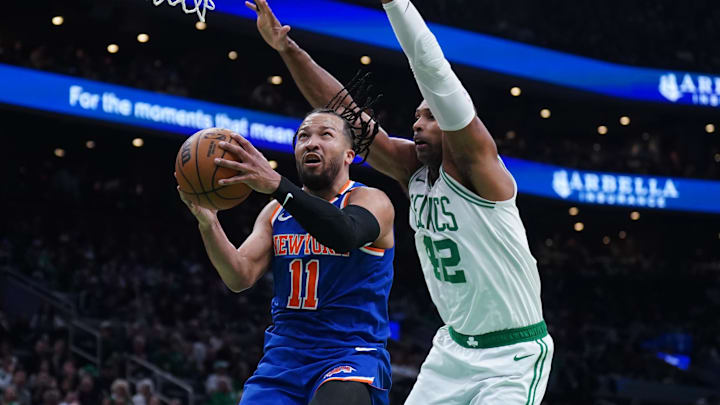The New York Knicks pulled out a thrilling come-from-behind victory over the Boston Celtics in Game 1 for a bunch of reasons. Their defense was frenetic, perhaps more so than ever. Jalen Brunson donned his cape, like almost always. The ascent of OG Anunoby continues to be front and center, too.
This list can go on, incorporating everything from rebounding to the pace at which the Knicks played in certain situations. But one thing not being talked about nearly enough is the degree to which New York went at Al Horford.
Boston's ever-steady 38-year-old big man is nowhere near a liability—not even when he's guarding in space. Yet going after him, repeatedly, ended up paying huge dividends. And the Knicks should be bent on trying to do it again.
Kristaps Porzingis' early exit changed the Knicks approach
Kristaps Porzingis is normally someone the Knicks' primary ball-handlers would look to target in pick-and-rolls. After he left Game 1, though, they shifted their focus to Horford.
That makes sense in a "If not him, then who?" vacuum. It is counterintuitive when considering how well Horford tends to hold up in space, and just generally on switches.
He wasn't suddenly putty in the Knicks' hands in Game 1, either. Their offense averaged 0.94 points per possession when Horford was on the floor. On those occasions in which he matched up with Brunson and Karl-Anthony Towns, New York's two best attackers, the team put up 0.96 points per possession. That is...incredibly low relative to the Knicks' typical production. They averaged almost 1.20 points per possession overall in the regular season, and they're at around 1.11 points per possession in the playoffs.
Still, this approach eventually worked. As John Schuhmann wrote for NBA.com:
"New York set 19 ball-screens for Brunson with Horford’s defender on Monday. That was the most for any ball-handler/screener’s defender combination in Game 1, per Second Spectrum tracking. The Knicks scored just 0.75 points per chance on those occasions, but they got some key buckets from that action in the fourth quarter."
As it turns out, it is those key buckets that lay the blueprint for how the Knicks should target Horford moving forward.
Boston changed the way it was defending because of New York
Like Schuhmann also noted, the Celtics began sending two to the ball after the Knicks lasered in on Horford. That is not something they tend to do. But it is something they may have no choice other than to do more regularly.
Horford is in so many ways ageless. In the end, though, age 38 is still age 38. He won't stay in front of Brunson forever. Nor can he always beat Towns to his spots. Not while needing to shoulder a much heavier workload without Porzingis.
Regardless of how the Celtics react to this approach, the Knicks seemingly win. If they throw two at the ball, New York can find the open man, and keep putting them into rotation. If Boston concedes the switch, like usual, it sets up a potential mismatch, particularly later in games.
Now, the calculus changes if the Celtics elect to defend straight up, rather than switch or double. Even then, though, the Knicks have options. Towns should be able to punish Horford in pick-pop situations. Failing that, New York can explore putting Brunson on him at the other end, in order to try creating cross-matches for its offense.
So many of the Knicks' later possessions in Game 1 suggest this can work. They had a 125 offensive rating in the final frame. That did not hold into overtime, but playoff tilts are essentially a bunch of chess matches rolled into a singular game.
Targeting Horford officially makes too much sense. It is one of the best chances that the Knicks have at creating a consistent advantage against this Celtics defense. And even when it doesn't deliver the most efficient results, it lays the groundwork to wear Horford down, and perhaps get him into foul trouble.
Failing that, we journey back to the original question: With Porzingis' status unknown, and his minutes potentially limited upon return, if not Horford, then who?
Dan Favale is a Senior NBA Contributor for FanSided and National NBA Writer for Bleacher Report. Follow him on Bluesky (@danfavale), and subscribe to the Hardwood Knocks podcast, co-hosted by Bleacher Report's Grant Hughes.
